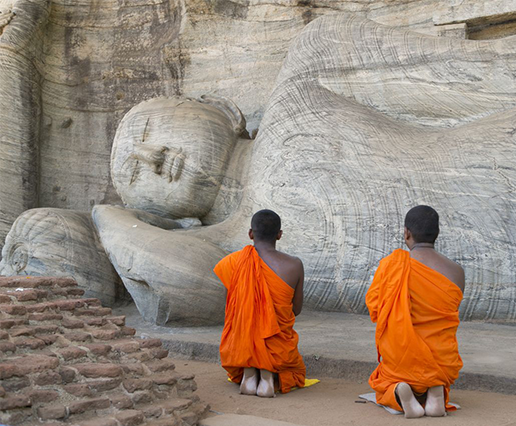It is reassuring in this day and age where, in tourism, the branded often overshadows the bone fide, that cultural holidays in Sri Lanka have something truly meaningful at their core. And that is Buddhism. It has been, and continues to be, the leading light that guides tourists here. Many are followers of Buddha from around the world, others simply fascinated by the religion’s history, the architecture associated with it as well as contemporary sacred practices.
No matter what your beliefs, it is hard not to be struck by the serenity, spiritualism and committed service of Buddhist monks seen at many of the country’s temples, whether they are ancient museum pieces or contemporary places of worship. Beira Lake, a landmark in the capital city of Colombo, for example, is home to hundreds of monks at Gangaramaya Temple. And there are thousands of monks in and around the Kandy region, where the Sri Dalada Maligawa or Temple of the Tooth is located, housing the sacred tooth belonging to Buddha. There are, in fact, 6,000 Buddhist monasteries in Sri Lanka with approximately 15,000 monks and, in many places, from the jungles to the beaches, you will hear chanting coming from all directions at sunrise.
The ancient Buddhist sites
A sapling of the Bodhi or Bo tree, sacred in Buddhism, was brought to Sri Lanka in the 3rd century BCE by the son of great Indian emperor Ashoka leading to the establishment of Sri Lanka’s first Buddhist monasteries and shrines. During this period, the kingdom was ruled by Sinhalese Kings at Anuradhapura. The ruins of this ancient city, part of the Cultural Triangle, are a very important place of pilgrimage in Sri Lanka still today. Particularly for people to honour Buddha at the Bo tree shoot.
Polonnaruwa
Polonnaruwa is another important place for Buddhist pilgrims, as it took over as capital and strived to protect Buddhism after it suffered under invading forces between 5th and 11th centuries. A magnificent and compact site, with superbly kept ruins, the stone carvings of Buddha are highly revered, and the whole site has gained UNESCO World Heritage status.
Dambulla Caves and the Golden Temple
Dambulla Caves and the Golden Temple date back to the 1st century BCE, so pilgrims have been trekking here barefoot for millennia now. A magnificent site, this is a sacred cave complex packed with Buddhist statues, adorned with hand painted frescoes depicting the life of Buddha, and was the hiding place of a Sinhalese King hiding from Hindu Tamils.
Mihintale
Mihintale is the hill top temple site where Buddhism was first introduced to Sri Lanka in the 3rd century BCE. A beautiful location surrounded by verdant hills, and the climb up 1,840 steps (ideally barefooted) to see the giant Buddha, is certainly an uplifting experience.



